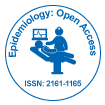The Parental Use of Antibiotics in Children in Saudi Arabia
Received Date: Jun 11, 2015 / Accepted Date: Jul 11, 2015 / Published Date: Jul 17, 2015
Abstract
Background: The overuse of antibiotics especially in children is becoming one of the most important public health issues worldwide. This study aims to assess the factors underlying the parental use of antibiotics for children in Saudi Arabia.
Methods: This is a cross-sectional study design. The study included 1104 Parents (52% were mothers) of children younger than 12 years old recruited from schools parental meetings in the Eastern Province of Saudi Arabia. Ordinal logistic regression was used to identify the factors influencing the parental use of antibiotics in children. Risk factors considered included parents’ demographic information, child health-related information, along with the validated Parents Perceptions on Antibiotics (PAPA) scales, an instrument that measures parents’ knowledge and beliefs, behaviors, adherence, seeking information, and awareness about antibiotic resistance.
Results: There is a high association between the frequency of cold episodes and the number of antibiotics used for the youngest child in the family during the previous year. Three parent-related psychosocial aspects appeared to be significantly associated with the parents’ tendency to use an antibiotic in their children: Knowledge and beliefs, behaviors, and seeking health-related information. Also, parent’s geographical background is associated with their use of antibiotics.
Conclusion: The strong association between the number of cold incidence and the amount of antibiotics used suggests an evidence for antibiotic misuse in Saudi Arabia. In addition, to stronger regulations relating to dispensing antibiotics, the Saudi government should implement public health interventions aimed at advocating parents to appropriate use of antibiotics, and the potential dangers in their misuse.
Keywords: Antibiotics use; Parents; Saudi Arabia; Multivariable models
Citation: Alumran A, Hou XY, Sun J, Yousef A, Hurst C (2015) The Parental Use of Antibiotics in Children in Saudi Arabia. Epidemiology (sunnyvale) 5:194. Doi: 10.4172/2161-1165.1000194
Copyright: © 2015 Alumran A, et al. This is an open-access article distributed under the terms of the Creative Commons Attribution License, which permits unrestricted use, distribution and reproduction in any medium, provided the original author and source are credited.
Select your language of interest to view the total content in your interested language
Share This Article
Recommended Journals
Open Access Journals
Article Tools
Article Usage
- Total views: 17564
- [From(publication date): 7-2015 - Nov 26, 2025]
- Breakdown by view type
- HTML page views: 12711
- PDF downloads: 4853
